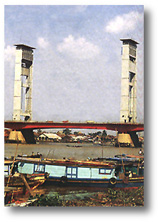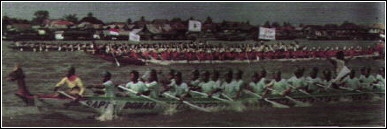
Find it Here FIRST! at Ferry Alayn Homepage
A Proud Member of the One and Only Network
Welcome to Palembang
One of the greatest Kingdoms in Indonesian history, the Buddhist
Empire of Sriwidjaja was founded
and prospered on the banks of Located on the southern-most
rim of the South China Sea, close
to one of the world's busiest shipping lanes linking the Far East
with Europe,
the region's historical background is rich and colourful.
The Sriwidjaja kingdom was famous for its bustling and lucrative
trade with
ancient China during the era of the powerful chinese dynasties
and in 672 AD,
the Chinese scholar I Tsing recorded that a thousand monks and
scholars could be seen studying
and translating Sanskrit in what is now the regional capital. Palembang;
a few of
the relics of this memorable era still remain.
Stretching from the foothills
of the mighty Bukit Barisan mountain range in West Sumatra to the islands
of Bangka and Belitung in
the East, the province of South Sumatra is relatively flat, but very fertile
with
numerous rivers cutting the
landscape and meandering their way to the sea. Coffee and tea are grown
in
plantations in various parts
of the province; but the area's enromous wealth comes from oil & natural
gas, coal, tin and quartz.
Palembang is still the gateway
to the province, and together with Tanjung Pinang on the island of Bangka
and Tanjung Pandan on Belitung,
provides the region's three major airports. All three cities have direct
connections to Medan, Batam,
Padang and Jakarta and in the future will benefit from the introduction
of
flights to Singapore. Air-Conditioned
buses to Palembang are available from points north and west of
Palembang on a regular basis,
as also from major cities in Java and Bali.
The Province of Jambi located
on the east coast of Central Sumatra, faces the Straits of Malaka Sharing
borders with four other provinces
in Sumatra and has long been a melting pot for different ethnic groups.
The earliest inhabitants of
Jambi were the "Kuburs". who were among the first wave of Malays to migrate
to Sumatra. The ancient kingdom
of Melayu flourished in Jambi and maintained its relation with the
mighty kingdoms of Sriwidjaja,
Majapahit and Singasari; but was eventually attacked and annexed by the
Sultan of Palembang in the
middle of the 17th century. Encompassing an area of 53,435 sq. km., almost
60% of which is forest, the
province of Jambi is home to a large variety of fauna and flora and an
exhilarating place for active
and adventurous visitors.

Ampera Bridge |

Bidar Racing |
THE MUSI RIVER
By Indonesian standards, the Musi river is both very broad
and long, compareble to those found on the big island of
Kalimantan, formerly known as Borneo. The river flows right
through the city, cutting it into two halves called the Ulu
bank and the llir bank and linked by two bridges of considerable
size and length, the Ampera and Musi II bridges. If
visitors are not inclined to make an interesting or unique
boat trip down the river, they could still walk half way across
the bridge to feast their eyes of the vast panorama surrounding
them, rare to any other place in Indonesia. Down
below they can see unbelievable heavy traffic of boats,
big and small, criss-srossing water lanes without accidents
as if steered by the most able navigators. From the same
spot both halves of the city are clearly visible as well. And if
the time is right, sunrises and sunsets as witnessed from
the bridge would be memorable experiences of nature's
beauty. Worth noticing are the floating restaurants and
shops on both sides of the river, and other intriguing scenes
of daily life of the city's inhabitants.
An interesting and attractive annual event is the Bidar
Race, held on 17th of August, the independence Day, or
around that time. The long and narrow boats are 24.5 metres
long and only 0.75 metres wide; each colourful boat
carrying as many as 50 oarsmen racing down the river with
drums thumping is a sight worth watching.
Indonesia is not only BALI, come and see our city PALEMBANG
"LIMAS" THE
TRADITIONAL HOUSE.
Another interesting tourist
attraction is the “Limas” houses which are still found scattered all over
the
province. Most of them are
built on riversides, though not facing the waterfront as in many western
beach-front properties. One
plausible explanation could be the need for privacy for the daily household
activities , out of sight
of passers-by.
These very ornate wooden houses,
built on stilts, are of rather sizeable measurements. They vary from
15 to 20 metres in width and
from 30 to 60 metres in length. A good part of the houses have
hand-carved columns, doors
and window frames. Carved wooden panels with flow-through patterns for
cross ventilation between
the rooms are placed just below the ceilings. Indeed, it is impossible
not to
observe the intricate designs,
patterns and colours of the carvings and admire the architecture,
craftsmanship and functional
style of these “Limas” houses, some of which are open to public.
KI GEDE ING SURO ANCIENT CEMETERY
This cemetery dates back to the 16th century. As many as
38 ancient tombs are there and one of the them belongs
to Ki Gede Ing Suro, one of the prominent forefathers of
South Sumatra's present society. Notably, all these 38
tombs are found under one roof.
THE STATE MUSEUM
Though in a relatively new
building erected in 1977, the State Museum with its collection of around
2000
relics and antiques that are
originals from this province would make a visit definitely worthwhile.
One
could see ancient household
articles, utensils, looms, hunting tools, a bridal room that reflects the
culture of the province and
some preserved animals of the region.
Beach lovers, touch and feel
the white sand beaches in BANGKA
BANGKA ISLAND'S MATRAS BEACH
Bangka can best be reached by air from Jakarta by scheduled
flights in just about an hour. However, boat services
from Palembang to either Muntok or Pangkal Pinang are adequate
and would not take more than an overnight’s
journey. This island that lies right at the mouth of the
Musi River in the South China Sea is one of the world's major tin
mining centres.
An exceptional beach of 300-400 metres width and 6.5 km.
length , called Matras Beach is located 44 km. north of
Pangkal Pinang, the island’s capital. Fine, white and clean
sand makes this beach most attractive to sunbathers and
beach-lovers. The Parai Beach Hotel with 35 rooms is right
on the beach.
On the other side of the island, at Mentok, you can find
the “Ranggam House” built in 1921 on the hill overlooking the
sea. It is like a big lodging house where at one time the
first Indonesian President was held captive along with some
of his close followers during the nation's political revolution.
The President's car of that time is still kept intact and can
be seen by the public during the house's opening hours.
Closer to the capital is the Pasir Padi Beach, just 7 km.
from Pangkal Pinang and is an ideal place to relax, swim and
sunbathe. There is a good hotel available at this beach.
Tourists come from the city and villages around this place to
this beach, which is 4 km. long in a genuine tropical setting
with endless coconut trees.
BELITUNG ISLAND
Adjacent to Bangka Island
is Belitung island, the other tin mining centre, and its capital is Tanjung
Pandan. If you are interested
in visiting both the islands, the best way to do it, is to leave by air
from
Jakarta to either of the islands
first, and then cross over to the other by boat and travel onward to
Palembang to explore rest
of South Sumatra. To save time, energy and money, it is recommended not
to make special side-trips
to Bangka and Belitung out of Palembang, but rather cover the three
destinations in one single
round trip.
The Belitung Tourism Development
Corporation is at present in the midst of developing a huge tourism
project at Tanjung Kelayang
Beach, half an hour from the capital by car. A complete beach resort hotel
with all modern facilities
is available since 1992 and Tanjung Kelayang Beach has all the promise
to
become a great and popular
tourist destination in the area because of its proximity to Singapore,
Sumatra and Java.
"PUNTI KAYU" NATURAL PINE FOREST RECREATIONAL
CENTRE
This recently built recreational complex covering an area
of 50 hectares consists of an amusement park, a
recreational park and a man-made lake in a natural forest.
In this complex you can also find a children's playground,
a cultural park, a souvenirs shop, restaurants and an
information booth. This complex, because of its proximity
to the capital and easy accessibility, mainly caters to the
local inhabitants of the city of Palembang; however, international
tourists may spend a calm day here watching the
local people having a good time.
"TENANG WATERFALL"
As South Sumatra is rich of
a number of small and big rivers, invariably waterfalls of various sizes
too
come with them . The biggest
in the region is the “Tenang" waterfall located in the Muara Enim Regency,
where the water rushes down
from a height of 90 meters into a deep pool and flow further downstream
in a strong current. By public
transportation the travel takes 2 hours from Palembang; however much
less time by private transportation.
KEMARO ISLAND
Situated at ten kilometres from Palembang, Kemaro Island
is a popular recreation site in the middle of the Musi river.
The island has a Buddhist temple.
-
-
Re-written from http://www.pusri.co.id




